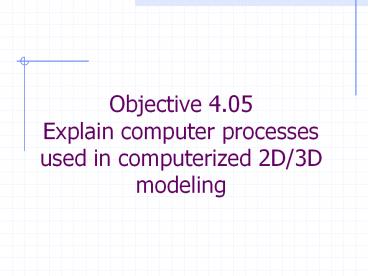Objective 4.05 Explain computer processes used in computerized 2D/3D modeling - PowerPoint PPT Presentation
1 / 27
Title:
Objective 4.05 Explain computer processes used in computerized 2D/3D modeling
Description:
Objective 4.05 Explain computer processes used in computerized 2D/3D modeling Computer Aided Design (CAD) A computer is a valuable technology tool. – PowerPoint PPT presentation
Number of Views:57
Avg rating:3.0/5.0
Title: Objective 4.05 Explain computer processes used in computerized 2D/3D modeling
1
Objective 4.05 Explain computer processes used
in computerized 2D/3D modeling
2
Computer Aided Design (CAD)
- A computer is a valuable technology tool. A
common industrial application for computer
systems is in preparing drawings and models.
3
Computer Aided Design (CAD)
- CAD refers to the process that uses a computer
and drawing software to assist the drafter in
preparing mechanical and architectural drawings.
4
Advantages of CAD
- Speed
- Quality
- Ease of modification
- Cost reduction
5
Speed
- A drafter can produce more drawings in a given
amount of time than using traditional drafting
methods.
6
Quality
- The overall quality of a design is improved by
increasing line quality, neatness, legibility,
and accuracy.
7
Ease of modification
- CAD drawings are stored in memory and can be
recalled and modified easily.
8
Cost
- All of the previously listed reasons make CAD
more cost effective than traditional drafting.
9
The number of dimensions greatly affects the
ability to view and display pictorial views of
the object.
10
Basic categories of CAD
- 2D packages store data for the X and Y
coordinates only. - 2.5D packages also store data points for the X
and Y coordinates, but they also provide
simplified 3D visualization for objects. - 3D programs store X, Y, and Z coordinates of each
data. A three dimensional database for each point
of an object. The z axis represents the vertical
axis in3 D modeling.
11
3D Systems Stereo Lithographic Apparatus (SLA)
- SLA produces full-size, 3D plastic models
directly from CAD drawings.
12
CAD Terminology
- Commands- short words which, when entered, causes
the computer to perform some function
13
CAD Terminology
- Entity an object or text item created using CAD
software
14
CAD Terminology
- Grids-The grid dots assist the drafter in drawing
entities. Most programs allow the drafter to
adjust the spacing of the dots. This is referred
to as grid spacing.
15
CAD Terminology
- Snap Grids-When snap grid is on, the cursor jumps
from grid point to grid point as it moves across
the screen. With snap grid, the cursor can only
be positioned at a grid point. Without snap
grid, the cursor glides across the screen.
16
CAD Terminology
- Rotation-The entity can be rotated by specifying
a specific angle of rotation, or it can be
rotated by grabbing on corner of the entity
(called a handle point) and dragging that point
around the base point.
17
CAD Terminology
- Zoom-allows the drafter to move into a particular
part of a drawing. By moving in on the drawing,
the drafter can view more details. This function
is extremely useful when working with very
detailed drawings.
18
CAD Terminology
- Tool bar a collection of tool buttons grouped
together.
19
CAD Terminology
- Windows- most CAD programs allow the screen to be
split into separate windows. Each window is a
separate display screen. The windows function is
useful when working on very large drawings.
20
Cartesian Coordinates System
- A method of graphical point location. All CAD
systems use this system as a standard. It allows
precise positioning of entities on the drawing
surface.
21
Coordinate pair
- Represents the position of a point. The first
number represents the X coordinate while the
second is the Y coordinate.
22
X,Y, Coordinate
- The X coordinate is the point's distance from the
origin along the X axis. The Y coordinate is the
point's distance from the origin along the Y
axis. The origin is the intersection of the two
axes. The intersection of the X and Y axes
creates four quadrants for plotting points.
23
(No Transcript)
24
- Notice, X and Y points in quadrant I are
positive. In quadrant 2, X is positive and Y is
negative. In quadrant 3, both X and Y are
negative, while in quadrant 4, X is negative and
Y is positive.
25
(No Transcript)
26
Absolute Coordinates
- Give the position measured from the origin of the
drawing. Absolute coordinates refer to precise
locations on the Cartesian coordinate grid. For
example, coordinates of 4,2 defines a point four
units to the right and two units above the
origin.
27
Relative Coordinates
- Refer to a point or location measured from a
previous point. For example, coordinates could be
specified for a second point that is at 8,4 from
the original point 4,2. To plot this second
point, you would move eight units to the right
and four units above the point 4,2. The absolute
coordinates for this second point would be 12,6.






























